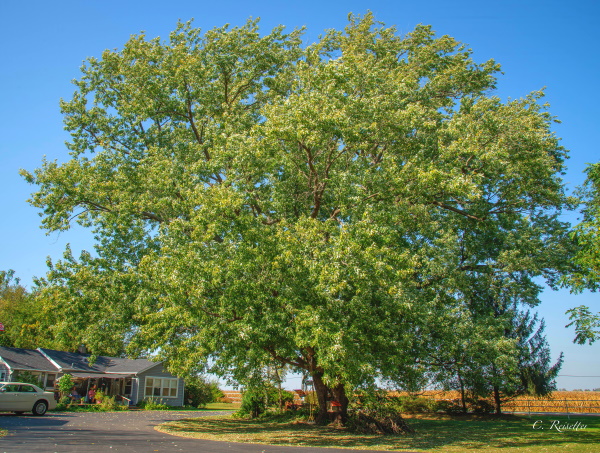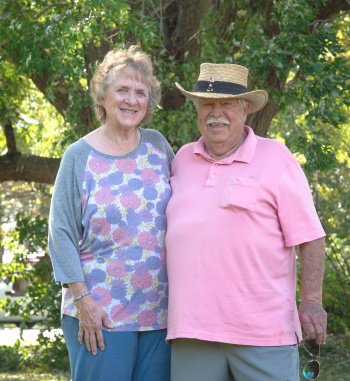Following is the Natural Land Institute’s Legacy Tree Program “Tree of the Month,” for October 2024,
Natural Land Institute’s Legacy Tree Program is pleased to recognize the 2024 October Tree of the Month. It is a Silver Maple that has been bringing the Kinsella family together for two decades. It is also distinctive because of its age and size.

The Silver Maple (Acer saccharinum) was nominated by Patrick and Lois Kinsella. It was measured by Howard Knodle, Natural Land Institute Board of Trustees and official University of Illinois Big Tree Inspector. The height is 87 feet; crown spread is 105.5 feet; circumference is 205 inches (that’s 17 feet!) NLI’s Legacy Tree Program continues to uncover large trees that outscore the current State champions. This silver maple grows in the front yard of the Kinsellas’ home (private property), west of Rockford, IL, on Auburn Road in Burrit Township.
Estimated to be more than 100 years old, the very special tree has been a hub for family activities since they moved to their seven acre farm in 2003. Lois Kinsella said they have hosted many family picnics and a couple of family reunions. With 90 offspring from her grandparents, reunions are huge!
“It’s the favorite spot to line up the lawn chairs. I have nine grandchildren; they all like to climb it and hang out on the horizontal limb, where the bird feeders and swing hang. They enjoy watching the birds and play with their imagination,” said Lois.
The Silver Maple attracts all kinds of wildlife. Lois loves to watch the birds at the feeders and how they use the tree. During spring migration, there is a lot of activity with Orioles, Indigo Buntings, Scarlet Tanagers, and many other birds that visit. Robins make nests in the tree every year. Squirrels and chipmunks run in and around the tree. Lois shared that “this tree has been a great source of joy for me and my family.”

Silver Maple becomes the largest maple in the region and has very high wildlife value. It is one of the first plants to bloom in spring (late February this past mild winter) but normally in late March. This first pollen and nectar can be an important source for bees, especially following a severe drought. The flowers are either male or female, often on separate trees. Female flowers produce the winged seeds, which rain down in early summer and are a feast for squirrels and chipmunks.
Silver Maples are called the “soft” maple, because they grow extremely fast and their wood is lighter and less strong than Sugar or Black Maples. They have a reputation of being weak wooded. If pruned properly early–so that the tree has good branching structure–they can become very large, wide-spreading trees like this one. Their main habitat locally is along our rivers and creeks, as the seed germinates in bare soil soon after falling. They also germinate in disturbed ground like flower beds or when caught in roof gutters!
Silver Maples have very high wildlife value from their flowers and fruits. A good number of insects feed on their foliage (native maples in the top 5 tree groups) and are an important baby bird food. The tree, in its natural floodplain habitat, often shows the scars of storms. Because the soft wood easily rots, the trees create important nesting and den cavities for wildlife. That is a reason why, if you have a Silver Maple in your landscape, you should make sure to prune it young, so cuts can heal over fast to prevent internal rot. Its role in the landscape does not conform to our expectations, but Silver Maple fills an important niche for nature.
Silver Maple is thriving in our modern atmosphere of increased CO2 and does sequester large amounts of carbon quickly with its fast growth, converting that carbon to wood. As the tree lives 125 years or so, it is not a long-term good solution to carbon sequestration but is certainly helping. It has become much more abundant in recent times.
The tree is not recommended as a yard tree, because its water-seeking roots can clog sewer and water lines. However, if you have a healthy tree in good condition, it is worth protecting and caring for. Fall color is almost always a rich yellow and very late in the fall season, often in November. It produces a sweet sap, but it takes much more sap to create maple syrup than the Sugar Maple.
Background and Information Request
Natural Land Institute launched the Legacy Tree Program in January of this year. It includes recognition of one tree a month that may be the largest of its kind, or have historical or cultural significance. Anyone may nominate a tree on private or public land from NLI’s 12 County region. Other components of the program, a list of the 12 Counties, the online nomination form, and the tree of the month since January can be found at https://www.naturalland.org/nlis-legacy-tree-program-january. Call 815-964-6666 or email info@naturalland.org.